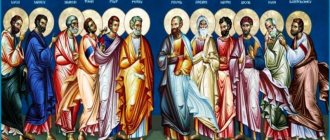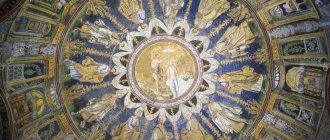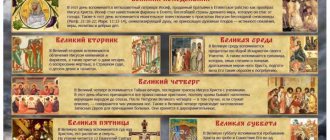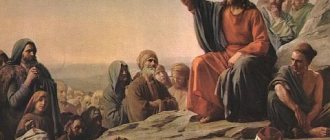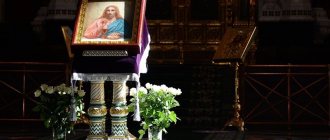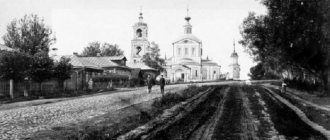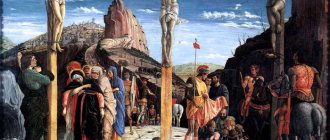The apostles are the closest disciples and associates of Jesus. They helped Jesus spread His teachings.
13. When the day came, he called his disciples and chose twelve from them, whom he named apostles
14. Simon, whom he named Peter, and Andrew his brother, James and John, Philip and Bartholomew,
15. Matthew and Thomas, James Alphaeus and Simon, called the Zealot,
16. Judas Jacob and Judas Iscariot, who later became a traitor.
17. And He went down with them and stood on level ground, and a multitude of His disciples, and a great multitude from all Judea and Jerusalem and the seaside regions of Tire and Sidon.
(Luke 6:13-17.)
The disciples of Jesus Christ were called apostles, which translated from Greek means “messenger”
Brief description of the lives of the twelve holy apostles of Christ
The life path of each saint is unique and therefore it is recommended to find out how the apostles lived before and after their meeting with Christ.
Peter
Peter was the elder brother of another saint, Andrew the First-Called. Before he met Jesus, he was a fisherman and had two children and a wife. At the same time, they called him not Peter, but Simon.
One day Jesus was visiting Peter's house. While visiting, he healed his mother-in-law of a fever. After this, Peter asked Christ for permission to follow him and became an apostle. It was he, and not the other disciples, who saw Christ walking on water. He was also the first person to believe that Jesus was the Son of God. Peter once denied Christ, but he immediately repented of it.
Andrey
Andrew the First-Called was the name of the apostle, who was the younger brother of Peter. From a young age he was distinguished by his faith in the Lord. Therefore, he did not marry and observed a vow of celibacy. At a young age, he approached John the Baptist to become his disciple. It was John who contributed to Andrei becoming one of the followers of Christ.
Andrew witnessed the miracle when Christ fed five thousand people with five loaves. He, along with James and John, also asked the Son of God about the destruction of Jerusalem, which happened in the seventieth year after the birth of Christ.
John Zebedee
The Savior loved John the Theologian very much for his virgin purity, love and sincere faith. When John was called by the Lord, he became one of the three disciples closest to Christ. The apostle witnessed many miracles performed by the Savior. For example, he saw with his own eyes the resurrection of Jairus’ daughter. He was also present at Tabor during the Transfiguration of the Lord.
After the crucifixion of Christ, the apostle began to serve the Virgin Mary. He was faithful to her until her death. Then he left Jerusalem and went to Ephesus and other towns in Asia Minor to preach the holy texts from the Gospel. He did this until the last days of his life.
Jacob Zebedee
James is the brother of John the Theologian, with whom he was called to serve Jesus. He was one of the three apostles who managed to become witnesses of the Divine mysteries. They saw how he brought dead people back to life, and were also present at the transfiguration.
When the Holy Spirit descended, Jacob devoted his life to preaching. Most often he preached in Spain, but sometimes he visited other countries. He then returned to Jerusalem and continued preaching here. He talked about Jesus, his life and the miracles he performed. In 44, the apostle was beheaded in Jerusalem.
Philip
Saint Philip was born in the homeland of Andrew and Peter, in the city of Bethsaida. From a young age, he was fascinated by the Holy Scriptures, so he understood and interpreted the meaning of all the prophecies contained in them. Philip became a disciple of the Lord at the call of the Savior.
When Christ ascended into heaven, the apostle began to preach in Galilee, where one day he managed to bring a baby back to life. He then went to Greece, where he continued to preach God's Word. Once Philip healed the wife of the ruler of the city of Hierapolis, thanks to which she became a Christian. Having learned about this, her husband ordered the apostle to be seized and executed.
Bartholomew
Bartholomew was one of the closest apostles of Jesus. After the crucifixion, he and Philip went to Asia Minor and Syria to preach and glorify the Lord.
After Philip was crucified by the pagans, Bartholomew visited India. He traveled around it, visited various cities, preached and healed people. During his life he managed to convert many pagans. To do this, he even had to translate some texts of the Gospel into their language. However, despite this, opponents of Christianity managed to kill Bartholomew for his faith.
Thomas
The Apostle was born in the town of Paneada and for a long time was engaged in fishing and trading fish. One day he happened to hear the gospel of Christ, after which he abandoned his previous life and became one of his disciples.
When Christ was crucified, Thomas did not believe in his Resurrection. Eight days after the Resurrection, he appeared to the apostle and showed him his wounds on his hands and feet.
After this, Thomas never doubted his faith and was faithful to the Lord until the end of his life.
Matvey
Before becoming a believer, Matvey worked as a tax collector, collecting taxes for the Roman authorities. One day he heard the voice of Christ, who called him to follow him. After that, he left his previous life and followed the Teacher.
Also, Matthew, like many other apostles, was engaged in preaching. Most often he glorified the Lord in Jerusalem, but whenever possible he also visited distant countries. In addition, it was Matthew who wrote the Gospel, which became part of the New Testament. The Apostle Matthew was executed on charges of witchcraft.
Jacob Alfeev
Jacob is Matthew's brother and was called together with him to serve the Lord. After the crucifixion of Christ, he devoted his life to preaching and glorifying the faith. Together with Andrei he went to Edessa to conduct sermons. He also spread the gospel throughout the territories of Eleutheropolis and Gaza. He then went to Egypt, where death overtook him. Jacob Alfeev was crucified in the town of Ostratsin, which is located on the border with Palestine. Just like Christ, he was crucified on the cross.
Simon Zealot
Born in Cana of Galilee, son of Saint Joseph the Betrothed. It was in Simon's house that Christ's first miracle took place - the transformation of ordinary water into red wine. After Simon saw that Jesus made wine from water, he believed in the Lord and became his follower. Simon is known for his Christian preaching. He preached in countries such as Britain, Libya, Egypt and Judea. On the territory of Abkhazia he was crucified on a cross. Simon was buried in Nikopsia, not far from Sukhumi.
Judas Iscariot
Judas, along with Simon, made up the last pair of apostles who became followers of Jesus. Iscariot was present at the anointing of the Savior with myrrh, which is described in detail in the Gospel. Each disciple of Christ had specific tasks; Judas was in charge of the money. It was he who betrayed Jesus for thirty pieces of silver.
After the crucifixion, Judas repented of his deeds and returned the money to the elders. Unable to bear his betrayal, he went to the Temple, where he hanged himself.
Judas Thaddeus
The Apostle comes from the line of Solomon and David, and is the son of the Betrothed Joseph from his first marriage. At first Judas did not believe in the divinity of Christ, but over time his opinion changed. Because of his weak faith, Judas could not call himself the brother of the Lord and therefore called himself only the brother of Jacob.
Judas began to preach the Gospel in the territories of Samaria, Galilee, Judea, Syria and Arabia. He then went to Edessa, where he completed the work of Thaddeus, who had previously preached in that city. Judas died in 1980.
What to pray for and what the icon helps with
Before the icon, Orthodox people pray for the following:
- about peace and love between people,
- about strengthening the spirit and faith,
- about help in difficult life situations,
- about the cure of physical and mental illnesses.
Daily prayer in front of this holy image helps protect against evil forces and resist temptations.
The revered icon of the 12 apostles is a symbol of the firmness of faith, love for mankind, humility and meekness. It was these qualities that helped the Lord’s disciples spread His Word throughout the world and build the New Israel - the Christian Apostolic Church.
Veneration and ecclesiastical significance
Nowadays, the holy apostles are considered an example to be imitated. Even now people remember their devotion, exploits and good deeds. They are glorified in prayers and even holidays are held that are dedicated to them. Most often, veneration resembles the veneration of saints. People bow to their relics to pray and ask for help. Orthodox Christians also worship icons and erect chapels and church buildings in their honor.
Prayer to the Council of the 12 Apostles protecting from troubles and problems
“O holy apostles of Christ: Peter and Andrew, James and John, Philip and Bartholomew, Thomas and Matthew, James and Jude, Simon and Matthew! Hear our prayers and sighs, now offered by our contrite hearts, and help us, the servants of God (names), through your all-powerful intercession before the Lord, to get rid of all evil and enemy flattery, and to firmly preserve the Orthodox faith that you have devoted to us, in which your intercession will not hurt us. , we will not be belittled by reprimand, nor by pestilence, nor by any wrath from our Creator, but we will live a peaceful life here and be honored to see good things on the land of the living, glorifying the Father and the Son and the Holy Spirit, the One in the Trinity, glorified and worshiped God, now and ever and ever forever and ever."
Iconography
The first images of the apostles appeared in the third century. There are two iconographic images that are used when painting icons depicting saints:
- Byzantine. This icon differs from the others in that the apostles are shown in full growth. Each of them holds scrolls on which the text of Christian teaching is written.
- Old Russian. Russian icon painters depicted saints in the form of grape vines. At the top is the Savior, and at the bottom are his disciples.
Symbolism of the number 12
The selection of 12 people among the chosen disciples has a deep symbolic meaning. By the time the Lord began his earthly life, out of 12 Israeli clans, only 2 were completely preserved. The Jews were convinced that the time would come when the Lord would gather all the descendants of the disappeared tribes on the land of Israel and restore their people.
The election of the 12 apostles is the first step towards the emergence of a new chosen people of God, which will include people of many nationalities, united by one Church - the New Israel.
John the Theologian (Zevdeev)
(Theologian) - author of the fourth Gospel and other books of the New Testament. He is nicknamed the Theologian because in his Gospel there is a lot of direct speech of Christ, the Word of God. Like Andrei, before meeting Jesus he was a disciple of John the Baptist. John, the youngest and most beloved disciple of Christ. It was he who reclined on the Savior’s shoulder during the Last Supper. He was the only one of the disciples who dared to be on Calvary during the Crucifixion, and before that he was next to the Lord during interrogations by the high priest and Pontius Pilate. Jesus bequeathed to him to take care of the Mother of God. After the Teacher left earthly life, John took Mary to his house.
The only apostle who died a natural death and in old age. Read more…
***
- About holy icons in questions and answers - Orthodox Christian Library
- Orthodox Church and sectarians. Holy icons. Holy Cross. Sign of the Cross - Archpriest Dmitry Vladykov
- Icon veneration in Orthodoxy - Metropolitan Macarius Bulgakov
- World of Icons - Deacon Andrey Kuraev
- Icon in Russian literature of the 19th - 20th centuries - Valery Lepakhin
- Development of the iconography of Prince Vladimir - Valery Lepakhin
- Orthodoxy and icon veneration - Sergei Govorun
- How much is Baptist opium for the people?! or Why do Baptists lie about icon veneration? — Alexander Pikalev
- The first letter of our holy father Gregory, Pope of Rome, to the Emperor Leo the Isaurian about holy icons
- Three messages from our holy father Gregory, Pope of Rome, to Emperor Leo the Isaurian about holy icons
- Against the Lutherans - A Word on the Worship of Holy Icons - St. Maximus the Greek
- Psychological symbolism of gestures in Christian iconography - Priest Dmitry Yurevich
- Why are there so many icons of the Virgin Mary? — Irina Yazykova
The most common type of apostolic composition is the image of the 12 Apostles surrounding Christ, which is based on the Gospel symbolism of the number 12, connecting the Old Testament (12 patriarchs, 12 tribes of Israel) and eschatological images (12 gates of Heavenly Jerusalem).
Early iconography of the scene (catacombs of Domitilla, late 3rd - mid 4th century, relief of a silver reliquary from San Nazzaro in Milan, 4th century, relief of a reliquary, mid 4th century (Museum in Brescia), - represented by the 6 Apostles) goes back to ancient images of the philosopher surrounded by disciples (for example, “Plotinus with his disciples” - relief of a sarcophagus (270).
Since the 4th century, the composition of the twelve apostles has been known in altar paintings, for example, the concha of the apse of the Church of San Lorenzo in Milan (IV century), and also the Church of Santa Pudenziana in Rome (400).
In the reliefs of sarcophagi, figures 12 A. can be located on the sides of Jesus Christ standing or sitting on the throne: each under a separate arch. Sarcophagus, 4th century (Arles, France). And also in pairs - the sarcophagus of Probus from the Cathedral of St. Peter in Rome (395), or in groups of 3, 4, 5 (sarcophagus from the Church of St. John of Studium in K-pol, 5th century).
Apostles. Sarcophagus of the 4th century (Arles, France)
Apostles. Sarcophagus Sample from the Basilica of St. Peter the Apostle in Rome, 395
In the center of the apostolic row, the Mother of God and Child can also be depicted (the chapel of the venerable Apollonius in Bauita (Egypt), which depicts 14 A., 6th century) and Etymasia (mosaic of the dome of the Arian Baptistery in Ravenna, around 520).
Apostle Peter (right with keys) and Paul. Mosaic of the dome of the Arian Baptistery in Ravenna
From ser. IV century The composition “Traditio Legis” (Giving of the Law), symbolizing the Divine fullness of the teaching of the Church received from Jesus Christ, became widespread.
In the center is the Savior standing on the mountain with 4 rivers of paradise (Gen. 2.10) with his right hand raised (a gesture of triumph) and an unrolled scroll in his left, on the left - the apostle. Pavel, on the right - Ap. Peter (mosaic of the Church of Santa Constanza in Rome, mid-4th century, gold painting on the bottom of a glass Eucharistic chalice, 4th century (Vatican Museums)).
Mosaic of the Church of Santa Constanza in Rome (mid-4th century)
Twelve Apostles. Sarcophagus (circa 400) in the Church of Sant'Ambrogio in Milan
Jesus Christ on the throne hands over the scroll to St. Pavel. Sarcophagus from the Church of Sant'Apollinare in Classe in Ravenna, 5th century
At the end of the 5th - 6th centuries, images of the 12 Apostles in medallions were placed in the space of the altar. For example, the Archbishop's Chapel in Ravenna; Church of San Vitale in Ravenna (circa 547) - on the arches of the altar vault; Catholicon of the VMC monastery. Catherine in Sinai (565-566) - in the apse; Church of Panagia Kanakarias in Lythrangomi in Cyprus (2nd quarter of the 6th century) - on the triumphal arch).
Apostle Andrew. Mosaic, 6th century. Basilica of San Vitale in Ravenna
In the VI century. The iconography “Communion of the Apostles” appears.
Eucharist. Mosaics of Hagia Sophia
In the post-iconoclastic period, a system of temple decoration developed in Byzantine art, in which images of the Apostles occupied a certain place.
Life-size figures were placed in the walls of the drum, and evangelists were placed in the sails (for example, mosaics of the Cathedral of St. Sophia of Kyiv, 30s of the 11th century).
The 12 Apostles were depicted on liturgical objects: full-length figures are represented on the reliefs of the doors of the Great Zion (Jerusalem) of the Novgorod St. Sophia Cathedral - a silver tabernacle in the form of a model of a rotunda temple (1st quarter of the 12th century NGOMZ) and the Great Zion of the Assumption Cathedral in Moscow Kremlin (XII century, XIII century, 1485 GMMK); images decorate the so-called. Small Sakkos Met. Photia (mid. XIV-XVII (?) centuries. GMMC); enamel fractions with half-figures of A. (8 medallions) on stole (late 14th - early 15th centuries SPGIKHMZ).
Figures of the apostles. Greater Jerusalem or Greater Zion (1st quarter of the 12th century)
Figures of the apostles. Great Zion of the Assumption Cathedral, 1486
Small Sakkos of Metropolitan Photius (front side). Assumption Cathedral of the Moscow Kremlin, end of the 14th - beginning of the 15th century
The 12 Apostles were part of the so-called. Apostolic Deesis (icon, 12th century from the Monastery of the Martyr Catherine on Sinai), and are also represented in the compositions “The Council of the Twelve Apostles” (icon, 14th century), “Sending the Apostles to Preach” (Tokaly-kilise (Cappadocia), icon 900 -950, Church in Timotesubani (Georgia), XIII century and the mark of the icon “Praise of the Mother of God with Akathist”, XIV century.
Council of the Twelve Apostles. Byzantine icon, XIV century
Images of the apostles on the stamps of the icon “Praise of the Mother of God, XIV century”
Apostles. Frescoes of the Church of the Holy Trinity of the Sopocani Monastery (Serbia), around 1265
In Rus' in the XV-XVII centuries. a variant of the composition “The Cathedral of the Twelve Apostles” in the form of a vine became widespread, in the upper part of the cut there is a waist-length Deesis, and in the curls there are half-figures of A. (tablet icon, 15th century, icon, 16th century, fresco of the Annunciation Cathedral of the Moscow Kremlin , mid-16th century, icon, 17th century, from the Assumption Cathedral of the Trinity-Sergius Lavra). This iconographic version, which has similarities with the compositions “The Tree of Jesse” and “The Vine of Christ,” entered Russian. iconographic originals, for example. Bolshakovsky, XVIII century.
Cathedral of the Twelve Apostles in the form of a vine. Bolshakovskaya icon, XVIII century
The 12 Apostles, among whom the leading position is occupied by the supreme apostles Peter and Paul, who is not part of the circle of evangelical disciples of Jesus Christ, as well as the evangelists Luke and Mark, belonging to A. from the number 70, are depicted in scenes of the gospel cycle (Ascension, Descent of the Holy Spirit) , in the compositions “Assumption of the Mother of God”, “Last Judgment”, “Eucharist”.
The number 12 in these images remains unchanged, because it symbolizes the fullness of the Church.
The composition of A. in these compositions may vary.
In addition to the 12 Apostles, images of the Apostles Peter and Paul are also traditional, the image of which also represents the Holy Collegiate Church (apse of the Church of Saints Cosmas and Damian, 526-530, triumphal arch of the Church of San Lorenzo fuori le Mura in Rome, 4th century), and 4 evangelists (sarcophagus, 6th century (Archaeological Museum. Istanbul), miniatures of the Gospel of Rabbala (Laurent. Plut. I. 56. Fol. 10, 586)).
Apostles Peter and Paul. Church of San Lorenzo fuori le Mura in Rome, 4th century
In the miniatures of some manuscripts, in addition to the evangelists, there are corresponding images of A. in front of each of the messages (Apostol. Moscow State University. Greek 2, 1072, Sin. 275, XII century; Music 3648, XIII century).
Apostle Paul. Miniatures from the Acts and Letters of the Apostles, 1072
Apostle John the Theologian. Miniature from the New Testament with the Psalter, 12th century
In addition to individual images and illustrations of gospel episodes from the 8th-9th centuries. cycles of acts and sufferings of the Apostles appear.
According to the description of Nicholas Mesarita (Descr. 1-11, 13, 37-42), back in the 6th century. In the dome mosaic of the Church of the Holy Apostles in Constantinople during the era of Emperor Justinian, there were images of the sermons of the apostles Matthew, Luke, Simon, Bartholomew and Mark.
The Khludov Psalter (Greek State Historical Museum. 129. L. 17, mid-9th century) presents 12 A. preaching to the peoples:
Khludovskaya Psalter. Miniature, 9th century
Scenes of the suffering of the Apostles are found in the miniatures of the Words of Gregory the Theologian (Nazianzen) (Paris. gr. 510), in the mosaics of the Church of San Marco in Venice, after 1200.
The history of the Apostle Paul is presented in the mosaics of the Palatine Chapel in Palermo, around 1146-1151, the acts of the Apostles Peter and Paul - in the painting of the Transfiguration Cathedral of the Pskov Mirozhsky Monastery, 40s. XII century, the cycle of acts of A. is in the painting of the Church of Christ Pantocrator of the Decani Monastery (Yugoslavia, Kosovo and Metohija), 1348.
In murals, manuscript miniatures and icons, hagiographic cycles are known that are largely based on apocryphal literature.
These are the paintings of the Church of Our Lady of the Matejce Monastery, near Skopje (Macedonia), 1355-1360, Russian. hagiographic icons XV-XVII centuries (“St. John the Theologian in the Life”, late XV-XVI centuries (CMiAR), “Apostles Peter and Paul with the Life”, XVI century (NGOMZ), “Apostle Matthew in the Life”, late XVII - early 18th century (YAHM)).
John the Theologian with his life. Icon, 16th century
Saints Peter and Paul in their lives. Icon, 16th century
In the 17th century under the influence of Western European tradition, images are created on the theme of apostolic suffering, for example, the icon “Apostolic Sermon” by master Theodore Evtikhiev Zubov, painted in 1660-1662.
Apostolic sermon. Icon, 1662. Icon painter Fyodor Evtikhiev Zubov
In the 16th - 17th centuries, in addition to the 12 Apostles, the program of temple painting included images of the 70 Apostles, placed on the slopes of the arches under the vaults (Savior Transfiguration Cathedral in Yaroslavl, 1563, Archangel Cathedral of the Moscow Kremlin, 1564-1565, Church of the Holy Trinity in Vyazemy (Moscow region), ca. 1600, Assumption Cathedral of the Trinity-Sergius Lavra, 1669) or on the arch of the porch (Savior Transfiguration Cathedral of the Moscow Novospassky Monastery, 1689).
The veneration of the Apostles was expressed in the dedication of numerous churches to them, both general cathedrals (St. Apostles in K-pol, 6th century, Thessalonica, 1312-1315), and those where their relics and shrines associated with them were located (the cathedrals of St. Peter in Rome, III century, San Marco in Venice, XII - early XIII century)
Nina Kvlividze
Based on materials:
Week - 11/17/2008.
Live Internet - 08/31/2015.
